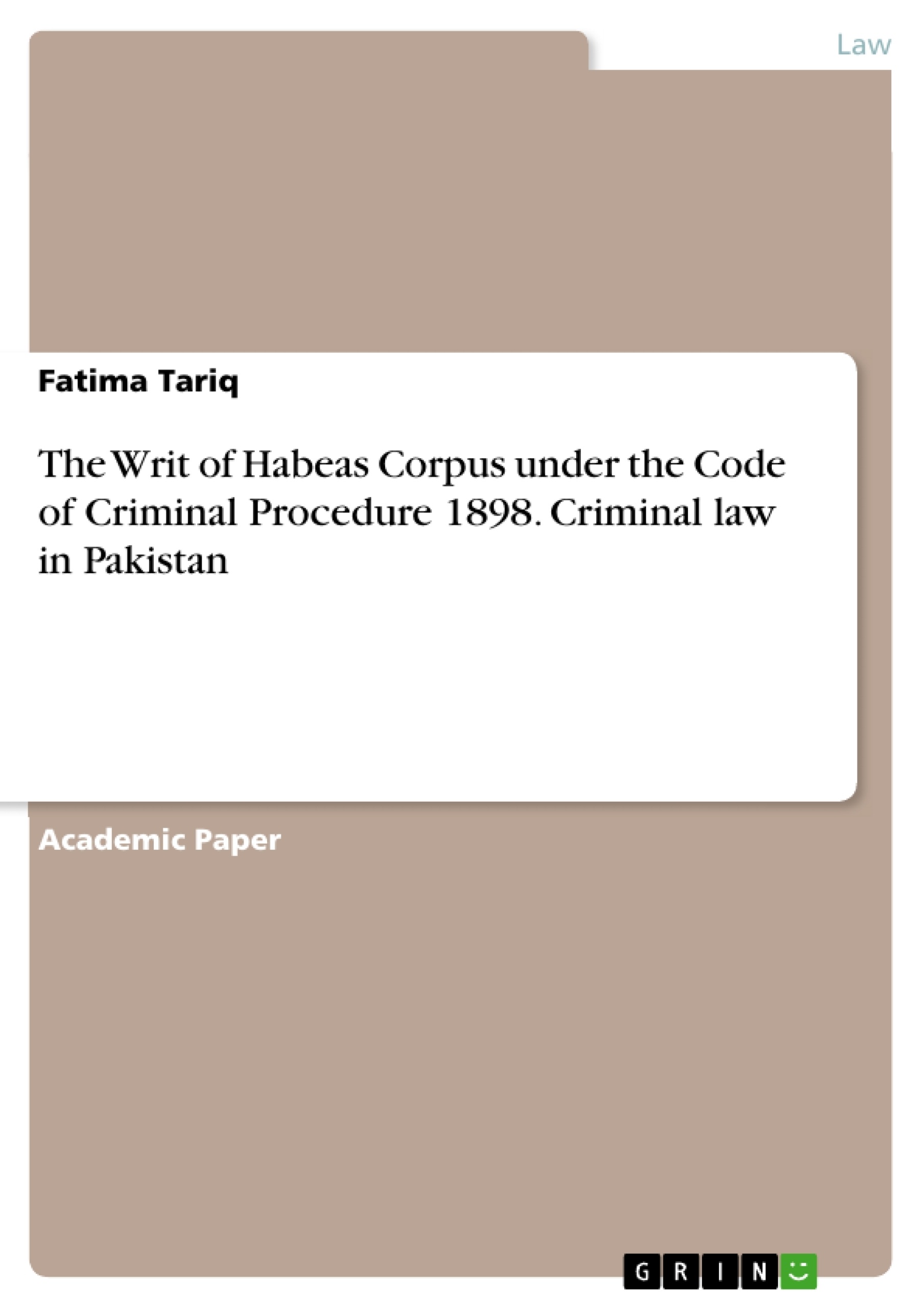The point of discussion of this paper is to have a detailed overview of the Writ of Habeas Corpus under the criminal law of Pakistan. The Writ of Habeas Corpus is sought to enforce the right to life. This paper will begin by discussing what Habeas Corpus is, and then it will discuss the legal provisions of Habeas Corpus applicable in Pakistan. It will explain section 491 CrPC with Article 199 of the Constitution of Pakistan.
A critical review of this doctrine will be given in this paper. It will briefly discuss the conditions necessary for the applicability of the writ of Habeas Corpus. Furthermore, it will be discussed what the law under CrPC explicitly states and how it is implemented by the judiciary. In addition, this paper will also discuss exceptions to the Habeas Corpus. It precisely states how the search for people who are wrongfully confined takes place. Relevant case laws have been cited.
Table of Contents
- INTRODUCTION
- RELEVANT PROVISIONS
- MEANING OF HABEAS CORPUS
- WRIT OF HABEAS CORPUS
- OBJECT OF HABEAS CORPUS
- HABEAS CORPUS UNDER SECTION 491 CrPC
- WHO CAN FILE APPLICATION UNDER SECTION 491
- POWER TO ISSUE DIRECTIONS OF THE NATURE OF HABEAS CORPUS U/S 491:
- HIGH COURT [Section 491(1)]
- SESSIONS JUDGE & ADDITIONAL SESSIONS JUDGE [Section 491(1A)]
- FRAMING RULES TO REGULATE [Section 491(2)]
- PREVENTIVE DETENTION [Section 491(3)]
- ORDER OF HIGH COURT
- MODES OF EXERCISING POWER
- Suo motu:
- On the application of aggrieved person:
- EXCEPTIONS TO HABEAS CORPUS PROCEEDINGS
- NATURE OF PROCEEDINGS UNDER SECTION 491
- SCOPE OF SECTION 491
- TWO FOLD JURISDICTION
- RESTRICTIONS/LIMITATION ON SECTION 491
- SEARCH OF PERSONS WRONGFULLY CONFINED:
- ACCORDING TO SECTION 100 CrPC:
- SCOPE AND APPLICABILITY OF SECTION 100 Cr.P.C:
- RESTORATION OF WOMAN OR FEMALE CHILD UNDER SIXTEEN YEARS: (SECTION 552)
Objectives and Key Themes
This paper aims to provide a comprehensive overview of the writ of Habeas Corpus under Pakistani criminal law. It will explore the legal provisions surrounding Habeas Corpus and critically analyze its application, including its conditions, exceptions, and the judicial process. The paper also addresses the search for individuals wrongfully confined, drawing upon relevant case laws.
- The legal framework for Habeas Corpus in Pakistan, including relevant sections of the Criminal Procedure Code (CrPC) and the Constitution of Pakistan.
- The conditions necessary for the applicability of Habeas Corpus, examining its scope and limitations.
- The different modes of exercising the power of issuing Habeas Corpus, including suo motu and applications by aggrieved individuals.
- The role of the judiciary in implementing Habeas Corpus and the exceptions to its proceedings.
- The search and recovery of individuals wrongfully confined, including the provisions of the CrPC relating to this process.
Chapter Summaries
- Introduction: This chapter sets the stage by introducing the concept of Habeas Corpus and its importance in safeguarding the right to personal liberty. It discusses the constitutional guarantees under the Pakistani law and the relevance of Habeas Corpus in enforcing these rights.
- Relevant Provisions: This chapter outlines the relevant legal provisions governing Habeas Corpus, including specific sections of the CrPC and Articles of the Constitution. It also provides cross-references to other relevant sections of Pakistani law.
- Meaning of Habeas Corpus: This chapter delves into the meaning of the term "Habeas Corpus" by exploring its literal and legal interpretations. It also refers to key cases that provide insights into the legal meaning of the writ in Pakistani jurisprudence.
- Writ of Habeas Corpus: This chapter discusses the historical origins and significance of the writ of Habeas Corpus in the English legal system. It explains the purpose and function of the writ in safeguarding against unlawful detention.
- Object of Habeas Corpus: This chapter explores the objective behind the legal provision of Habeas Corpus, highlighting its role as a remedy against illegal confinement and ensuring the proper administration of justice.
- Habeas Corpus under Section 491 CrPC: This chapter examines the power granted to the High Courts under Section 491 of the CrPC to issue Habeas Corpus writs. It explains how this provision empowers the courts to address cases of illegal detention and ensure compliance with the law.
- Who Can File Application under Section 491: This chapter clarifies who can file an application for Habeas Corpus under Section 491 of the CrPC, outlining the eligibility criteria and procedures involved.
- Power to Issue Directions of the Nature of Habeas Corpus U/S 491: This chapter details the various entities authorized to issue Habeas Corpus directions under Section 491, including the High Courts, Sessions Judges, and Additional Sessions Judges.
- Order of High Court: This chapter examines the powers and procedures of the High Court in issuing Habeas Corpus orders, explaining the scope of their authority and the legal grounds for issuing such orders.
- Modes of Exercising Power: This chapter explores the different ways in which the power to issue Habeas Corpus can be exercised, focusing on the concepts of suo motu (on its own initiative) and applications filed by aggrieved individuals.
Keywords
Key terms and concepts central to this work include Habeas Corpus, writ of Habeas Corpus, right to personal liberty, illegal detention, Article 199 of the Constitution of Pakistan, Section 491 of the CrPC, constitutional safeguards, fundamental rights, search of persons wrongfully confined, and case laws.
- Quote paper
- Fatima Tariq (Author), 2020, The Writ of Habeas Corpus under the Code of Criminal Procedure 1898. Criminal law in Pakistan, Munich, GRIN Verlag, https://www.grin.com/document/1242958




